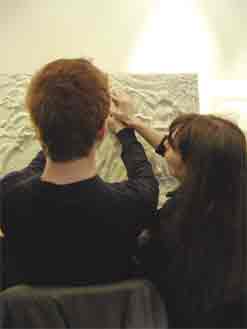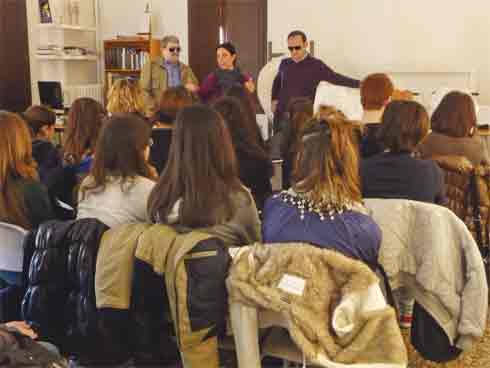To learn about a works of art with eyes closed, relying on touch, and following its shapes with fingertips, to recreate in one's mind, is an emotional experience which usually pleases children, gives youth confidence, and brightens up adults, because at all ages our relationship with senses changes and can be nourished from one time to the next by instinct, spontaneity, shyness, modesty and reflection. For twelve years, the Institute for the Blind Francesco Cavazza's tactile museum of old and new paintings, Anteros, has been exhibiting a collection of tridimensional translations in bas relief of painting masterpieces dedicated to people living with vision loss, and welcoming school group visitors of all ages. Penetrating the imagination requires abilities of synthesis that evolve in the course of one's life, starting at a young age, since seeing with the mind means to understand human creativity as a requirement of the mind and the heart. The tactile museum Anteros organizes all teaching and educational activities linked to school visits contributing to the school and social integration of students living with vision loss, within and beyond the class group. To cultivate sensibility, through the refinement of the senses, is therefore among the priorities of educational interventions and the departure point to support teachers, educators and parents. Reflections stemming from the knowledge captured through seeing and touching artistic images also come from our knowing, feeling, and understanding. And for this, every moment of enjoyment of art should not separate the poetry of children's emotions and their intense intuition, in order to encourage the discovery of inner resources, even when it could be tiring to do, and to intensify the depth of how we perceive things. Since it is not easy to be young and grow up, it is useful to link aesthetic values of art to ethical values and motivations sufficient to hear a youth say "yes, I like this way of learning, it helps me, it probably makes me more attentive, serene, available". Among the works of art that catch the most the imagination of children are the Birth of Venus by Sandro Botticelli, for the harmony and gentleness that it inspires; the portrait of the horse Morel Favorito by Giulio Romano, a moving story of loyalty between a horse and its rider;
the Allegory of Prudence by Tiziano Vecellio, for the expanse of senses in the passage of time and the generations to come, as an heritage of affections and principles; and most of all the Great Wave by Katsushika Hokusai, the ancient symbol of the creating and destructive strength in nature. Children intervene during the slideshow that precedes the haptic experience and they follow with curiosity the red dot by the laser beam on the projected images. They experiment the selective itineraries of the eye and of the hand, with the help of guides, and when with their eyes closed they let go and go along with the discovery of slow pace, then emerges the beauty of trust, the value in listening. Everything comes from the quality of perception and in the understanding of functions related to expression and communication in art, between fun, discovery and learning. Cultivating the quality of perception is useful to establish a contrast with the load of information we passively receive, a danger of our time, and it requires from us to think about how to practice a sense of critique, and our ability to discern, and to propose an aesthetic experience without diminishing it and emphasizing its scope. For this reason, school groups visiting the tactile museum Anteros probably discover a new way to enjoy aesthetic emotions, they experience the here and now with respect, as though the language of the senses, sifted by the intellect, is freed from anxiousness and emotional listlessness.

To take the time to listen and to enjoy the beauty of new knowledge that is not ready-made, it is necessary to be interested in what is being received and offered, without preconceived ideas, with what is essential. The visit at the museum includes the clay modelling labs for blind and low vision people of all ages, culture and training. Worthy of note is that all school groups consider the tactile experience as a real opportunity for inner enrichment. The purpose of the guided visits is finally to dissolve or at least reduce the conceptual and cultural distances between various existential conditions, to aim the sharing of models of representation and meaning of verbal and visual language, respecting the diversity of perceptual, cognitive and interpretative approaches of art as a metaphor of life.
